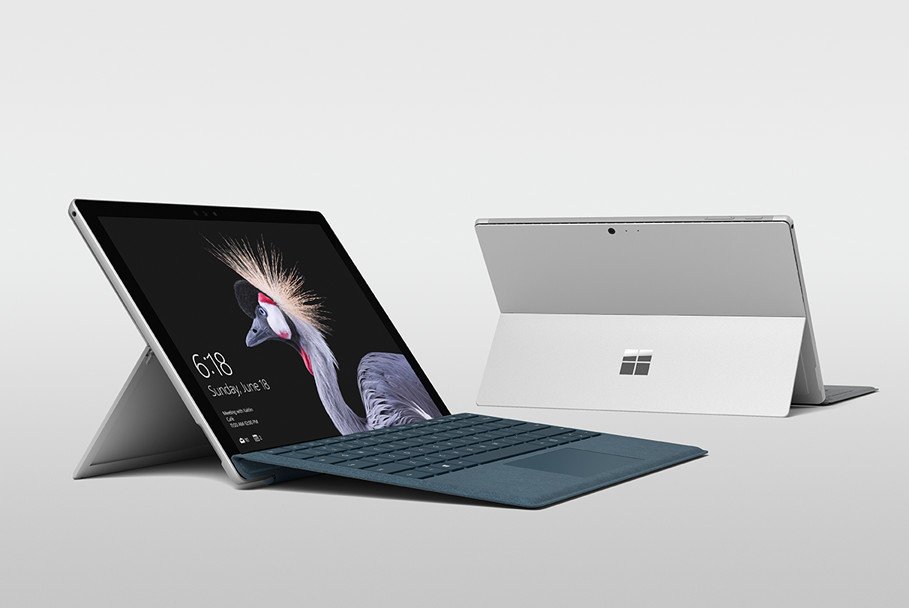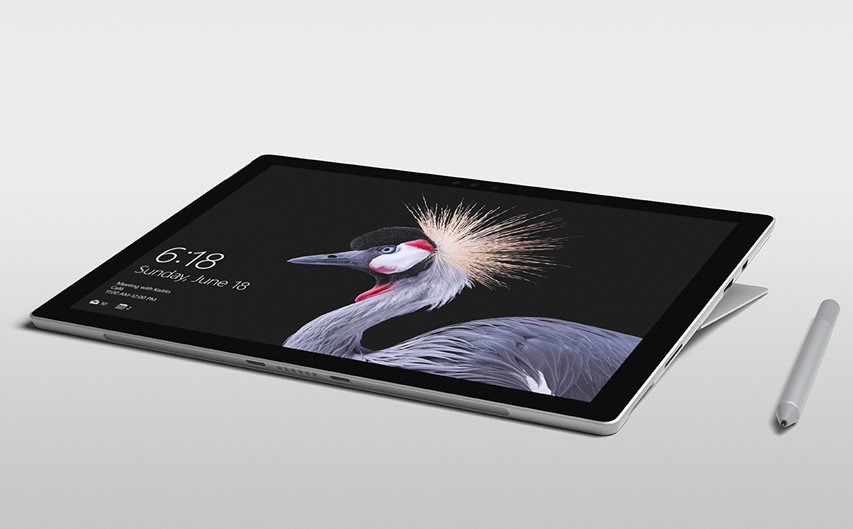Surface Laptop vs. Surface Pro: Spec showdown and form factor wars
Microsoft just unveiled the new Surface Pro with shiny new internals and an array of upgraded features.

The 2-in-1 tablet form factor remains a divisive point, so much so that Microsoft recently unveiled a classic Surface Laptop clamshell for people who find the Surface Pro's hybrid configuration a little off-putting.
Still, I'm of the opinion that the Surface Pro remains a great option, even with the clamshell configuration now available. But is it right for you? Let's discuss the "pros" and cons (see what I did there? Pros?... sorry.)
Tech Specs
Both the Surface Pro and the Surface Laptop are incredibly similar on the inside, but there are a few differences worth noting. We've highlighted in bold when a device wins the spec battle.
| Category | Surface Pro (2017) | Surface Laptop |
|---|---|---|
| OS | Windows 10 Pro | Windows 10 S (upgradeable to Pro) |
| Screen Size | 12.3 inches | 13.5 inches |
| Screen Resolution | 2736 x 1824 (267 ppi) | 2256 x 1504 (201 ppi) |
| Processor | 7th Gen Intel Core m3, i5, i7 | 7th Gen Intel Core i5, i7 |
| RAM | 4GB, 8GB, 16GB | 4GB, 8GB, 16GB |
| Graphics | m3 and i5: Intel HD 620; i7: Iris Plus 640 | i5: Intel HD 620, i7: Iris Plus 640 |
| Storage | 128GB, 265GB, 512GB, 1TB (SSD) + microSD expansion | 128GB, 256GB, 512GB |
| LTE Option | Yes | No |
| Rear Camera | 720p | None |
| Front Camera | 1080p (With face authentication) | 720p (With face authentication) |
| Ambient light sensor | Yes | Yes |
| Accelerometer | Yes | No |
| Gyroscope | Yes | No |
| Ports | Full USB 3.0, Mini DisplayPort, Surface Connect, headset jack | Full USB 3.0, Mini DisplayPort, Surface Connect, headset jack |
| Speakers | Stereo speakers, Dolby Premium | Omnisonic speakers, Dolby Premium |
| Height | 11.5 inches | 12.13 inches |
| Width | 7.93 inches | 8.79 inches |
| Thickness | 0.33 inches (without keyboard) | 0.57 inches |
| Weight | 1.69 pounds (without keyboard) | 2.76 pounds |
| Battery (listed) | 13.5 hours | 14.5 hours |
| Price | $799 to $2,699 | $999 to $2,199 |
Both the Surface Pro and Surface Laptop utilize the latest processors from Intel, but the Surface Pro comes with an m3 option for those looking for something even cheaper. Interestingly, the i5 version of the Surface Pro is, like the m3, fanless in design, which means it will be practically silent compared to its i7 counterpart. Every version of the Surface Laptop is equipped with a fan, though we've yet to spend any time with either the new Surface Pro or the Surface Laptop in an isolated and quiet setting where we could put them under load and see just how noisy the fans are.
Previous Surface Pro models have struggled with throttling due to heat generation. Kaby Lake Intel processors could go some way to improve the situation, but if you'd prefer peace of mind when it comes to thermals, the Surface Laptop might be a better bet. But this is, again, something that's hard to judge without a thorough analysis.


In any case, both devices should perform similarly, with the Surface Laptop edging the Surface Pro into second place when it comes to battery life. Part of that, however, might be due to Windows 10 S, which blocks Win32 programs like Chrome which are known to impact battery life.
Windows 10 S vs. Windows 10 Pro
The Surface Laptop comes with Windows 10 S, Microsoft's new super-secure OS locked to the vetted Windows 10 Store. It is upgradeable for free until the end of 2017, giving you access to the full compliment of Win32 programs on the market: Steam, Adobe CC, and beyond. After 2017, it will cost around $50 to purchase a Windows 10 Pro upgrade license, which is still cheaper than usual.
Get the Windows Central Newsletter
All the latest news, reviews, and guides for Windows and Xbox diehards.

Students will probably get far more out of the Surface Pro for note taking, due to its form factor.
The Surface Pro comes with Windows 10 Pro as standard, because Microsoft expects it to be used by professional artists who rely on programs like Clip Studio and Adobe Photoshop. I think Microsoft missed an opportunity, though, at least with the fanless m3 and i5 versions, as I feel these would make for pretty great tablets with Windows 10 S, but perhaps that's for another discussion.
Because Windows 10 S is so easily upgraded, it shouldn't really factor into your purchase decision between the two devices, but if you're a student simply looking for a standard clamshell that will run Office programs and a web browser efficiently, the Surface Laptop is a safe bet even without the upgrade to Windows 10 Pro.
That said, students will probably get far more out of the Surface Pro for note taking, due to its form factor.
Form factor wars
While the Surface Laptop supports inking, it's not something you'll enjoy doing. The screen doesn't tilt back nearly as far as the Surface Pro, and being a laptop you can't quite curl up with it in a chair and draw. Expect to use inking on the Laptop more for utilitarian purposes — signing and annotating documents, for example — than artistry. If you intend to make extensive use of the pen — sketching, drawing, taking notes by hand, etc — then the Surface Pro tablet is a great option.


The Surface Pro's kickstand/tablet configuration is oft-criticized as having poor "lappability," i.e. it's difficult to use on your lap like a, well, laptop. The kickstand has been improved yet again with the new Surface Pro — it's more stable for lap-typers and more flexible for artists that want to fold it back nearly flat (a full 165 degrees). This will work well with the newly supported Surface Dial, another huge boost for artists.
Price
This is where things get a little complicated. The price listings for the Surface Pro only include the tablet. No keyboard, and no pen. The keyboard alone adds $160 to the equation, throw in the new tilt-shifting pen (which we expect to be $100), and a Surface Dial ($100), and that Surface Pro starts to look extremely expensive by comparison. If you want the Surface Pro form factor, chances are you're going to want at least the pen and the keyboard.

The 512 MB, Core i7, 16GB RAM Surface Laptop costs $2,199, the same as the Surface Pro. Throw in the keyboard cover and pen, and the Surface Pro becomes $2,459, which is a significant bump. If you're spending money at the high-end, an additional $260 might not bother you so much, but if you're going for the lower-end devices to save money, it's something worth considering. You're going to have to really want that Surface Pro drawing, inking configuration to justify the extra costs.
Which is right for you?
The new Surface Pro and Surface Laptop are mostly evenly matched on specs and are fairly close in price. It comes down to a matter of form factor, and that's a debate for the ages. If it's art or handwriting or flexibility that's your draw, then the Surface Pro's 2-in-1 tablet design is likely the best for you. If you're planing on doing a lot of typing — or simply have no need for digital inking in your life — the Surface Laptop should rank higher on your list.
Of course, there is Surface Book to consider as well, artfully bridging the divide between the tablet and laptop. Though right now, after the unveiling of the Surface Laptop and new Surface Pro, the Book is comparatively out-of-date when it comes to the chips inside.
For now, let us know your thoughts on the laptop vs. 2-in-1 hybrid war in the comments below. Which would you rather get?

Jez Corden is the Executive Editor at Windows Central, focusing primarily on all things Xbox and gaming. Jez is known for breaking exclusive news and analysis as relates to the Microsoft ecosystem while being powered by tea. Follow on Twitter (X) and Threads, and listen to his XB2 Podcast, all about, you guessed it, Xbox!
